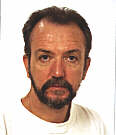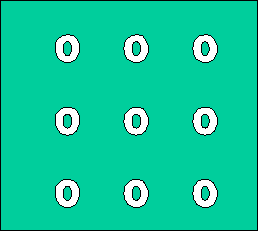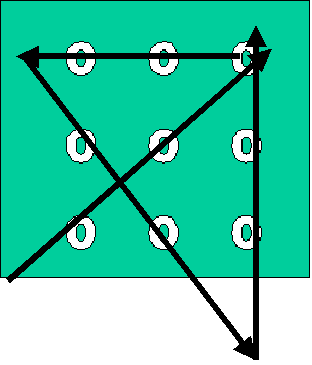 |
Out of School Bounds
by Tom Maguire *
 |
One of my pupils set me a brain teaser the other day. The challenge was to link up the rings below with four straight lines passing through all nine rings and without lifting the pencil. (Answer at the end.)

The trick to doing it is to draw outside the boundaries of the square. That is, literally outside the mental "box" delimited by the 9 rings. To complete the teaser you have in fact to draw outside the boundaries of your thinking.
Problem-solving is of course one of the main activities in schools, especially in maths, physics and chemistry classes. The other principal occupation is linguistic, be it analysing your own language, reading literature or learning other languages. The rest of the curricular activities such as P.E., music or cookery are looked upon as secondary. School tends to be a staple diet of numeracy and literacy.
It is important to learn how to deal with numbers and words, but it makes for a rather restricted education. It also sidelines people who may have skills that do not fall within the constraints of the present system. They are labelled as less able or less intelligent. Skills like carpentry and art may be allowed a place, but only an inferior status within a structure which is assembled with letters and figures.
Howard Gardner's theory of Multiple Intelligences (Frames of Mind: The theory of multiple intelligences, Basicbooks, NY, 1983) points up just how confining this formal school education is. Children who are less able at calculation and verbal or written skills are quickly labelled as less intelligent. However, outside school many of these failed pupils do well. Albert Einstein is a famous case. The reason for this is that the present curricular boundaries are too narrow and cater for only a quarter of the recognised human intelligences.
We can begin to widen the bounds of the education system simply by encouraging students to develop a broader sense of intelligence and their own worth. You can do this by explaining to pupils that in traditional school education we give almost exclusive importance to two main intelligences: language ("word smart") and numbers ("number / reasoning smart"), but that there are, at present, six more recognised intelligences. From time to time you can briefly mention one of the others:
• Spatial intelligence ("picture smart") (Famous example: Stephen Spielberg)
• Bodily-Kinaesthetic intelligence ("body smart") (Famous example: Lewis Jordan).
•
Musical intelligence ("music smart") (Famous example: Paul
Simon).
• Interpersonal intelligence ("people smart") (Famous example: Teresa of Calcutta).
* Intrapersonal intelligence ("self smart")
• Naturalist intelligence ("nature smart") (Famous example: Jacques Cousteau).
Two of these intelligences – the intrapersonal and the interpersonal – have become famous through Daniel Goleman’s work (Emotional Intelligence, Bloomsbury, UK, 1999). He knits the two together into one emotional intelligence which combines the personal and social skills involved in dealing with people, yourself as well as others. Goleman goes on to suggest that this is the intelligence behind success in life and as such should be formally integrated into the educational curriculum.
The learner’s emotional state is a central element in learning as educators are now beginning to recognise. In a recent exhaustive investigation, Developing the Emotionally Literate School, (Paul Chapman Publishing, UK, 2004) Katherine Weare concludes that :
“… a positive emotional state is a crucial prerequisite for learning.”
One way of attaining this state is the promotion of emotional literacy defined as ‘the ability to identify, understand and express emotions in a healthy way’. This innovative approach would enable both teachers and students to address another of the self-imposed boundaries of school : negative feelings. So how do we go about this?
In order to push back the emotional limitations in schooling The Children's Emotional Literacy Project (www.kidseq.com) suggests three straightforward steps:
1. Identify your feelings in words. (cross, angry, hostile, furious, enraged)
Some teachers take the time to ask their pupils how they feel at the beginning of class. They then build on the pupil's answers by eliciting a little more information on the feeling and helping to define it more precisely. The rest of the class is also learning how to analyse their feelings and put them into words.
2.
Express the problem in words (“I
can’t learn languages.”)
The second step involves dealing with negative beliefs, among other things.
In
his book Changing Belief Systems with NLP, (Meta Publications 1990)
Robert Dilts offers a framework which enables us to explore the way in which we
construct beliefs. The model of organisation he proposes distinguishes 5
different levels : Environment - Behaviour - Capabilities - Beliefs - Identity.
For example if a child is having problems with spelling, she might perceive the
problem from any one of the 5 viewpoints:
- Environment: “I don’t spell well because I can’t concentrate in this noisy atmosphere.”
- Behaviour: “I don’t put effort into concentrating so I misspell.”
- Capabilities: “I’ll have to develop better spelling strategies.”
- Beliefs: “Spelling is not as important as creative writing.”
- Identity: “I am a poor student.”
The impact on the student of one of these perceptions will range widely, depending on the level chosen, from the Environmental : “I can’t spell because of the surrounding noise.”, to Identification: “I am not intelligent”. The problem is that these perceptions are unconscious and thus seen as eternal truths, not possible viewpoints. Emotional literacy involves learning how to put our beliefs about learning into perspective by identifying their level and meaning. Instead of embracing the debilitating belief that she is unintelligent, the student above can be motivated to improve her spelling strategies by the belief that in this way she will be better able to express herself creatively.
Teachers’ positive or negative beliefs about their pupils can also have a potent empowering or adverse effect on their learning. You may have heard about the Rosenthal study done in the USA. It illustrates well the power of teacher beliefs in the classroom. A group of children were tested and found to be average learners. The group was then subdivided into two random subgroups. One subgroup had a teacher who was told that the pupils he was taking were “gifted”. The teacher of the other subgroup was told that his pupils were “slow learners”. The assessment of the two groups at the end of the year showed that the majority of the group which had been arbitrarily named as “gifted” obtained higher scores than they had previously, while the majority of the supposed “slow learners” scored lower than they had before. One conclusion we can draw from this experiment is that the majority of children in the two subgroups conformed to the beliefs their teachers had about them, not to their real capabilities. This is a startling example of the power of the educator’s beliefs to enable or disable their students through their own beliefs.
3. Ask yourself : “What can I do to change my feelings, thinking, and behaviour.”
NLP offers a variety of tools for introspection and change. Teachers and parents can consult bibliography on the subject at: http://www.xtec.es/~jmaguire/nlp/index.htm#read
Of course one of the most general beliefs in schools is that teachers teach and learners learn. The truth is that everyone learns at school, though it may not be what the curriculum stipulates. In fact nowadays, particularly in classes which use information technology, the teacher will learn a great deal from pupils. We can get the ‘correct’ answer very quickly using technology, but learning changes when problems don’t have a single answer. Instead of memorising the right answer it is the approach to learning that become the centre of focus. This learning to learn process empowers the teacher to discover and promote pupils’ different creative strategies and solutions.
In the end my pupil taught me that the answer to his brain teaser was to ignore the boundaries imposed by the rings. Is this another boundary pushed back : pupil teaches teacher?
Answer :

![]()
Tom Maguire has a BA (English), M-ès-Lettres (French) and Philology degree (Spain). He has 29 years experience in TEFL in France and Spain. At present he teaches EFL in a Spanish State high school near Barcelona and is participating in a pioneering Catalan website to give academic support to students, teachers and parents (www.edu365.com). He is interested in using Neuro-linguistic Programming (Nlp) to enhance Learning to Learn. He is a Master Practitioner in Nlp and manages a listserv for those interested in Nlp in Education.